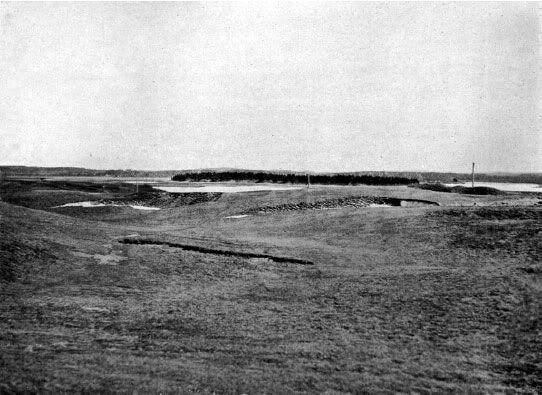In David's photos you can see that the intent was to grass the face of the Redan bunkers. But you can see signs of erosion between the grass clumps that are on that slope. I submit that those faces took a lot of time to grass in. They appear to be planted with fescue. Fescue is very slow to move laterally to fill in voids. It requires more seed and time to fill in the voids. I'm sure the adage would have been, if at first you don't succeed, seed seed again. They may have even used plugs of fescue plants to fill in the voids on those bunker slopes. And this was on bunkering that was being irrigated with the greens watering. Whereas all the bunkering, through the green, benefited from no irrigation before 1913, unless if they hauled water wagons to those sites during grow-in.
Bradley,
Are you really saying that you can tell by my photos that they were having problems growing in the Redan bunkers, and that you can see "signs of erosion?" That would be pretty impressive, given the photo, posted here again . . .

Surely you agree that despite what you see as "signs of erosion between the clumps" the grass face is pretty much grown in?
In fact, in all the photos I have posted, do you see any bunkers that look like they were supposed to be grass faces, but were not because of the grow in porblems? I don't.
As for the date NGLA began watering its fairways, see the quote by Hutchinson above.
With TEPaul's ranting you may have missed my question above. What do you think of the bunkers a few posts above, on the cape hole. We seem to have a sand faced bunker with a sharp edge, a grass faced bunker (in the foreground) and a couple bunker where the sand goes close to the lip but not quite. Would you agree with me that all of these bunkers appear to have the look that was intended? In other words, they do not look like that because of grow in issues, do they? I don't see any signs of erosion or serious grow in issues, do you?
_______________________________________________________________
Brad:
Go back and check out Moriarty's post #153 and take note of the two bottom photos on that post (the golfers in the Sahara bunker of NGLA). It is very interesting to me that Moriarty failed to include the photo in that 1926 article just below those two photos that shows the fronting bunker on the "Bottle" hole with its distinctly grassed down face to a flat sand floor. Talk about selective evidence and argumentation! 
Bradley, TEPaul apparently has forgotten or ignored most of the early posts, or he is intentionally trying to muddy the record. So let me again clarify a few points:
1. I have written repeatedly and from the beginning that
not ALL of the bunkers had the wilder, flashed faced style as seen in some of the photos. See a few posts above, where I wrote this in response to a question from Anthony:
"But it was not all flashed-face rugged bunkers then, so I assume that it wasn't intended to be. There were obviously some of these, but there were also some flashed face bunkers with a more defined edge, and also some grass faced bunkers. All three of these types can be seen photo immediately above. CBM emphasized variety in almost every aspect of golf course design." So TEPaul's insinuation is nonsense. Again.
2. Each of the photos from 1926 shows a different bunker. The first is the diagonal bunker on the Alps hole, the second on the Sahara.
___________________________________________
At this point, Bradley, I am not sure what you are arguing. It is well documented that NGLA had grow-in troubles in 1907-1908, and also that it is difficult to grow grass in pure sand. No one is arguing this.
But your
problems in grow-in theory does not support your conclusions with regard to the look of any of the photos shown, does it?
1. The roughest and wildesy bunkers shown in the photos were still rough and wild in 1926.
2. The rest of the bunkers appear to look pretty much as intended, don't they?